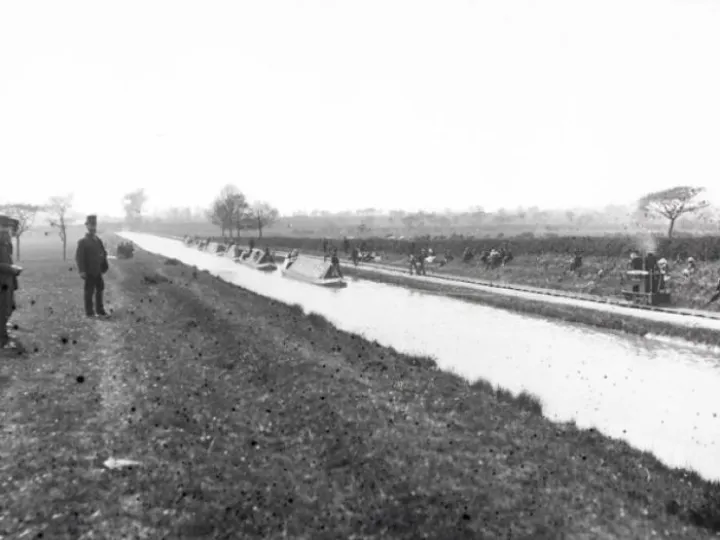







Church Minshull History of our Waterways
By Sue Russell
There's a gem of a waterway flowing through the backyard of Church Minshull – the Middlewich Branch of the Shropshire Union Canal. Scenic, rural and very popular, the 10 mile stretch from Barbridge to Middlewich is part of the vast network of over 2,000 miles of canals and rivers in England and Wales. Given time and the right length of boat it's possible to travel from Ripon and Skipton in the north, to Bristol in the south west, and to Cambridge and London in the east, passing through cities such as Manchester, Birmingham, York, Leicester and Oxford, affording very different views to those seen by the average tourist.
The Middlewich Branch opened in 1833, relatively late in terms of canal construction. The Trent and Mersey Canal (linking the River Trent to the River Mersey and passing through Middlewich) had not been enthusiastic about the idea of joining up with the Shropshire Union Canal (linking Wolverhampton to Chester and Ellesmere Port) because of the threat of cargoes transported on their waterway being diverted via the Middlewich Branch  to the north west. They eventually agreed to the link but insisted on building a short branch from their canal to join the Shropshire Union, and the Wardle Canal in Middlewich was constructed. At 47 metres in length, including one lock, it remains the shortest canal in the country. The Trent and Mersey Canal then levied high compensation tolls for traffic passing through the lock, until the tolls were abolished in 1888.
to the north west. They eventually agreed to the link but insisted on building a short branch from their canal to join the Shropshire Union, and the Wardle Canal in Middlewich was constructed. At 47 metres in length, including one lock, it remains the shortest canal in the country. The Trent and Mersey Canal then levied high compensation tolls for traffic passing through the lock, until the tolls were abolished in 1888.
In 1888 about a mile of 18" railway track was laid on the straight towpath stretch between bridges 5 and 6 at Cholmondeston and a small locomotive named 'Tiny' from Crewe railway works was used to haul boats. Although the locomotive could haul up to 8 barges at 7mph the process proved impractical and no further action was taken.

The Middlewich Branch was dominated by through traffic and there were several wharves, including at Nanny's Bridge, below Minshull Lock and Minshullhill Bridge 14 in the village – plus a transhipment warehouse at Barbridge. The commodities transported would have been as varied as foodstuffs (such as cheese and milk products) to minerals (such as salt and coal). Carrying traffic ceased around the 1920s and from then onwards canals generally slipped into disrepair due to competition from the railways. The restoration and leisure use of the canals was spearheaded by the Inland Waterways Association created in 1946 by Tom Rolt, following his four month canal trip on Britain's neglected canals. The journey included a lengthy stay in Church Minshull which he described in considerable detail in his book 'Narrow Boat'.
A serious breach of the canal on 12th October 1958 occurred at the Church Minshull viewpoint and was recorded in the Crewe Chronicle. The breach was purported to have been caused by a burrowing rat and drained 7 miles of canal between Minshull Lock and Stanthorne Lock. A 3 hour cascade of 20 million gallons of water flooded into the field and the River Weaver below and resulted in a gouge 15' deep by 100' wide. The breach was repaired within a month. The pictures are from the family archives of Brian Charlesworth, who can also remember another breach by his farm in the 1960s.
It is tempting to romanticise the lives of the over 100,000 carrying boat men, women and children who lived and worked on our rivers and canals in often appalling conditions, constantly on the move on a 'no work, no pay' basis. Today in contrast the canal provides a leisure experience for walkers, cyclists, fishermen and pleasure craft. The Branch forms part of 'The Four Counties Ring' a week long, 109 mile boating route taking in Cheshire, Shropshire, Staffordshire and the West Midlands, Cholmondeston Lock being the 3rd busiest on the network.
Quick Links
Get In Touch
VillageArena is powered by our active community.
Please send us your news and views using the button below:



